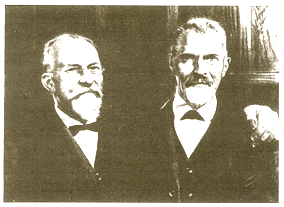



German immigrants Henry Lomb and John Jacob Bausch joined forces to in 1853 to create Bausch and Lomb. John was an Optician and Henry was a Financer making the opportunity vast and viable together. This is one of the first giant companies in the optical world, original founders of the Ray ban brand.
Founded in Rochester, NY Bausch + Lomb is one of the worlds’ largest suppliers of eye health care products. John Jacob Bausch passed away in 1926, leaving his brother Edward Bausch as the Chairman of the Board. Bausch + Lomb went public on the NYSE in 1937 raising $3.6 million in stock for working capital. There were 17,000 products available at the time of the public offering from eyewear to scopes.
During the preparatory period for World War II, Bausch + Lomb stockpiled foreign material while searching for US based materials to ensure they could continue to support their lens business with restricted foreign relationships. At this same time they were focusing their efforts on perfecting professional photographic lenses for use in the movie industry. Due to their contribution to the movie industry, Bausch + Lomb were awarded an honorary Oscar. This new film industry revenue brought Bausch + Lomb $21 million in 1940.
By1950 sales had soared to over $48 million. The organization had over 150 glass grinding labs across the United States to facilitate its massive lens manufacturing business. During this same time period the company was investing heavily in research and development as well as forecasting product demand prior to investment.
By 1959, Bausch + Lomb hired the 1st non-family member president, William McQuilken. Under McQuilken’s leadership, the organization grew to $70 million by 1962. By the late 60’s B+L developed the 1st soft contact lens changing faces around the world. The lenses were met with many challenges including materials coming from Czechoslovakia, FDA hurdles for regulatory compliance in the drug market as these lenses were classified. By 1971 the lenses were made available to the public and sold 100,000 pairs in their first year of availability. By 1973, soft contact lenses accounted 50% of the organization’s revenue.
In 1980, B+L acquired a former Abbott Labs executive, Daniel Gill to be their new chairman. This new executive focused on marketing and branding, getting product placement in feature films. Notably the Ray ban Wayfarer that was won in the 1983 movie, Risky Business catapulted that frame from 16,000 unit sales the prior year to 360,000 the following year. By 1986 the Ray ban brand held 33% market share of the $500 million sunglass market. The 80s also brought about diversification in corporate product lines including dental products and even acquisition of an existing lab mice farm that produced significant income.
In the early 90s corporate restructuring took priority as well as selling off less profitable divisions. International growth was also a priority at this time. The manufacturer was earning 40% of its income outside the United States. By 1994, the company’s stock price had tripled since the early 80s.
By 1999 The Company had sold Ray ban to Italian Luxury Eyewear manufacturer, Luxottica for a reported $640 million. By 2007, Bausch + Lomb sold to a private equity group, Warbus Pincus, LLC.
Fast forwarding to today, Warbus Pincus sold its Bausch + Lomb entity to Valeant Pharmaceuticals for $8.7 billion. Today the company is headquartered in New Jersey with over 13,000 employees worldwide focusing their efforts on the optical market.